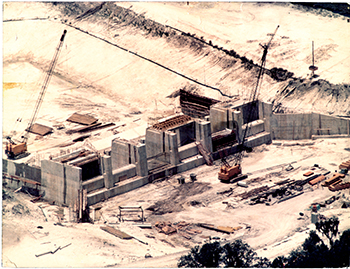The District’s birth was prompted by a hurricane. Its initial mission was to provide flood protection; however, by the end of the decade, the fledgling agency was already maturing to address broad-based water management needs.
During the 1960 hurricane season, Hurricane Donna hammered Florida with 128-mph sustained winds and massive flooding. Donna caused storm surges of up to 13 feet in the Florida Keys and 11-foot surges along the southwest coast of Florida. Portions of southern and western Florida received more than 10 inches of rainfall from the hurricane. Hurricane Donna still holds the record for retaining major hurricane status in the Atlantic Basin for the longest period of time.
“The District was formed as a result of Donna,” said Dale Twachtmann, who served as the District’s executive director from 1962 to 1972. “It was a real crisis. In Masaryktown, people lost their homes and their businesses. Farmland was underwater. Tens of thousands of chickens drowned during the hurricane.”

Left to right, State Sen. James Connor, U.S. Congressman Sam Gibbons, Gov. Farris Bryant and Governing Board Chair Alfred McKethan oversee children cutting the ribbon for the grand opening of the District’s Brooksville Headquarters.
On Aug. 28, 1961, the Board of Governors of the Southwest Florida Water Management District held its first meeting in Tallahassee. The Governing Board hired the District’s first employee on Nov. 1, 1961: Clint Schultz, a bookkeeper, typist and overall office assistant. The second employee was Carolyn Stewart, a secretary for Joe Fuller, a Governing Board member who was also performing the duties of an executive director.
Twachtmann was the third employee to be hired in the District’s early formation. When Fuller left the District in mid-1962 to become the executive director of the Florida Democratic Party, the Governing Board made Twachtmann acting executive director. He became permanent executive director on Feb. 13, 1963. “My job, as ’Employee Number Three,’ was to get the word out on the Four River Basins project to all the counties in the District,” he said.
Four River Basins
The District was created in 1961 by a special act of the Florida Legislature to be the local sponsor of the Four River Basins, Florida Project. This $57 million flood control project, designed by the U.S. Army Corps of Engineers, encompassed a 6,000-square-mile area including the Hillsborough, Ocklawaha, Peace and Withlacoochee river basins. The project authorized construction of canals, flood control structures and water detention areas to provide flood protection for the region.
By March 1962, the District’s 11 watershed Basin Boards were organized: Alafia River, Crystal-Homosassa River, Green Swamp, Hillsborough River, Northwest Hillsborough, Ocklawaha River, Peace River, Pinellas-Anclote River, Pithlachascotee River, Waccasassa River and Withlacoochee River.
The District’s Governing Board and staff of three held monthly meetings in a rented Brooksville office. “We immediately began buying land for flood control projects,” said Twachtmann. “We needed land for the Tampa Bypass Canal. We acquired large amounts of acreage for the Lower Hillsborough River Flood Detention Area.”
The District quickly got to work on flood protection. Engineering and recreation planning for the Tampa Bypass Canal began in 1963. In 1964, the Four River Basins project made its first land acquisition with the purchase of the land for the Lake Tarpon Outfall Canal. Construction broke ground on the first section of the Tampa Bypass Canal in 1966. Lake Tarpon Outfall Canal construction also began in 1966. The Tsala Apopka Outfall Canal broke ground in 1967 and was completed in mid-1968. Work on bridges for the Masaryktown Canal project began in mid-1969, and the first bridge was finished by the end of the year.
Water Supply
Memories of Donna’s massive flooding quickly faded as the region slipped into drought. From late 1962 into 1963, while Twachtmann told residents that the District was working hard on the Four River Basins project to provide flood protection, residents were struggling with a lack of rain.
“People were asking me why we were spending all this money on flood control when their problem was a lack of rain,” said Twachtmann. “The problem at that time was drought, not flooding.” Additionally, disputes among counties and public outcry about water supplies and pumpage impacts frequently occupied the District’s agenda. In 1962, the District sought permission from the Legislature to weigh in on the potential impacts of pumpage in northern Tampa Bay and coastal counties. The District promoted legislation that allowed it to regulate water use, which was passed by the 1963 Legislature. At the same time, the District initiated water resource studies of problem areas.
Other evidence of water problems appeared. In 1966–1967, 15 new sinkholes appeared in northern Tampa Bay near pumping centers, indicating a serious drop in the water table. “People were telling me that their wells were going dry,” said Twachtmann, “and they wanted to know what we were doing about it.” The findings of the water resources studies along with considerable public debate on water issues resulted in the District designating itself a Regulatory District in 1968, becoming the first water management district to utilize regulation in water resources management.

The Tampa Bypass Canal’s S-160 Flood Control Structure under construction in 1968. The bulk of the canal system was built in the District’s first decade.
In 1969, the District requested Congress to expand the scope of the Four River Basins project to add a “multipurpose” aspect that added water supply as a component of the project.
“That let us change the design of the Tampa Bypass Canal, and eventually it was a major help to the City of Tampa,” said Twachtmann. “Tampa was running out of water, but the change to the project allowed the city to use some of the water from the canal for drinking water.”
As water supply assistance developed into a core mission, the District’s responsibilities expanded. Protection of the aquifer soon became an important District function through regulation of the regional wellfields serving the Tampa Bay metropolitan area.
Housing the District
Soon after the District’s formation, the small rented office in downtown Brooksville was outgrown. Finding the land for the headquarters was a much different process than it is today. Alfred McKethan, the District’s first Governing Board chair, got things started.
“Mr. McKethan called me and said, ‘Dale, go out to the Hernando County Aviation Authority — I’ve told them you’re coming — and pick out a nice piece of land that fronts on US 41.”
McKethan, a Brooksville native, was president and chairman of Hernando State Bank, president of the Florida Bankers Association and a former chairman of the Florida State Road Board. His newest focus became water when then-Gov. Farris Bryant appointed him to lead the District’s first Governing Board.
Twachtmann paced off five acres on the Hernando Airport property and put in some stakes with red flags. Once the site was identified, construction could begin. The District built its first Brooksville Headquarters’ office building in 1964; industrial buildings were added in 1966.
Natural Systems
Through the District’s first decade, flood protection problems were met head-on with engineering solutions. Through the Four River Basins project, the U.S. Army Corps of Engineers designed and constructed canals, bridges and flood control structures. It was the District’s job to acquire the land and agree to operate and maintain the project.
Struggling with the problem of supplying drinking water to the thirsty and growing Tampa Bay area, the commissioners of Hillsborough and Pinellas counties looked at using the northern section of Tampa Bay as a solution. Why not turn the Courtney Campbell Causeway into a dam and convert northern Tampa Bay into a freshwater reservoir? The county commissioners approached the District for help.
“We got in enormous trouble in a big hurry,” said Twachtmann. “The fledgling University of South Florida objected to the idea. Other biologists started coming out of the woodwork, telling us what a bad idea this was.”
The biologists pointed out that the area was the nesting grounds for the brown pelican. Scientists “began giving us lessons — in every public forum they could think of — on the biology of the bay. They said the project would create a big stinking mess,” said Twachtmann. “It was a mammoth change in our early days. Most of us were engineers, but we began listening and realized they were probably right.” The District Governing Board had already approved the project, and it was moving forward, but soon he and the small staff went to the Board and recommended canceling the project.
“I hated the fact that we just didn’t know very much about the environmental side of the equation,” said Twachtmann. “There were things to be considered about the saltwater environment, the freshwater environment, the birds and the critters; there were more matters to consider than just the engineering point of view.”
This new perspective affected the District’s oversight of the Four River Basins projects. The District began asking the Corps for changes to construction methods to ease environmental damage during construction. The U.S. Congress enacted the National Environmental Policy Act in 1965; and in 1968, Florida’s new constitution made the protection of natural resources a state priority. The District subsequently hired its first biologist.
By the end of the 1960s, the District had grown from a fledgling agency with three employees and a singular mission of managing a U.S. Army Corps of Engineers’ flood control project to an agency with more than 100 water management professionals wrestling with the issues of flood protection, water supply and understanding of the natural systems that were affected by the construction projects. The District was preparing to meet the new water management and environmental challenges of the 1970s.
